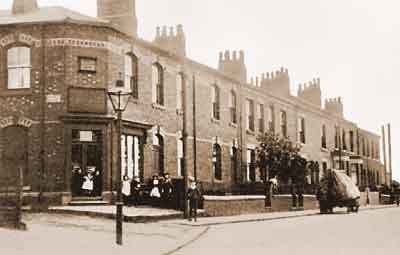 |
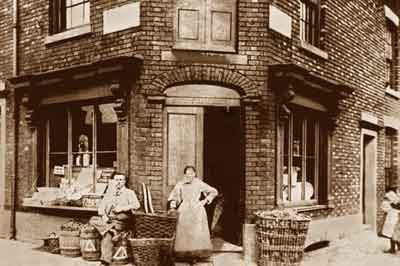 |
Haughton Green Rd, early 20th century. Francis Blake’s grocer’s shop on the east side of Haughton Green Rd adjacent to its junction with Two Trees Ln and Mill Ln. Francis Blake was born at Didsbury on the 3 Feb 1844 to Edward Blake and Jane Nicholls who were married at St John’s Church, Manchester, on the 17 Jul 1843. The family moved to Hyde where Francis was employed as a brush maker. He married Mary Lawton at St John’s Church, Godley, Hyde, in 1865. There was no issue. Mary died at Hyde in 1885, aged 44 years, and Francis married widow Martha Briggs, née Brown, at St Mary’s Church, Haughton Green, in 1887. Following Martha’s death the shop was occupied by Elizabeth Alexander and her widowed mother and by 1914 it was occupied by Charles Frederick Barrow. |
Haughton Green Rd, c.1900. George Sibley’s grocer’s shop on the corner of Haughton Green Rd and Gibraltar Ln George is seen here with his first wife, Jane Stansfield. George Sibley was born at Misterton (formerly Minsterton), Somerset, in 1851 and he moved to the Denton area in the 1860s where he was employed as a coal miner. He married Jane Stansfield at St Paul’s Church, Portwood, Stockport, in 1869. His wife was born at Denton in 1849. The couple had two children, Elizabeth (b. at Denton, 1870) and Matthew (b. at Denton, 1872). The couple also adopted a son, Thomas Edge. Jane died at Denton in 1905, aged 56 years, and he married Mary Jane Knight at St Mary’s Church, Haughton Green, in 1907. |
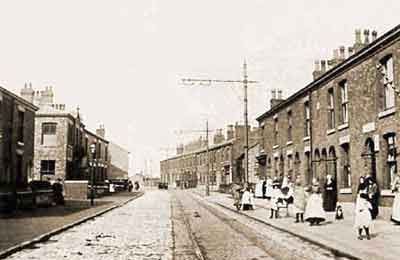 |
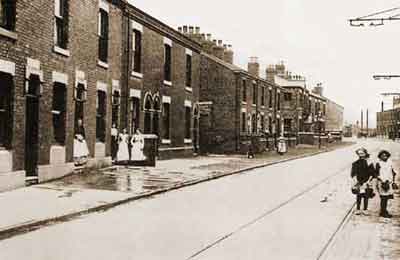 |
Haughton Green Rd, c.1910. View looking towards Two Trees Ln and Mill Ln. The building on the left by the gas lamp is the Conservative Club and almost opposite, on the right, the front of Manor Farm can just be seen. |
Haughton Green Rd, c.1910. View looking towards Two Trees Ln and Mill Ln from outside the Old Dog Inn, which is off the picture to the right. The children on the right are taking meals to their families working at Gibraltar Mill at the bottom of Gibraltar Ln on the far side of the river Tame. |
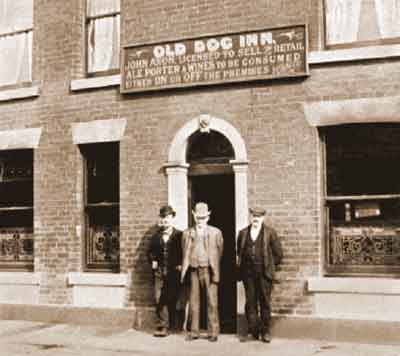 |
The Old Dog Inn, c.1906. John Axon, son of Charles Axon, is standing in the doorway and he was the publican between 1902 and 1910, following the death of his father in 1901. This beerhouse began in 1859 by the adaptation of a cottage located on the north side Haughton Green Rd and the Spice Inn is now on the site. The original cottage is still extant but much altered by alterations in 1964/65. When it was first licensed in 1859 William Axon was the publican and with only a short break it remained with the Axon family until 1952. The 1901 census records Charles Axon (56) as the publican and the 1911 census records the widowed Emily Axon (37) as the publican. By 1939 the publican was Charles Axon (37) resident with his wife, Muriel Frances, and son, John. Credit: F Rhodes. |
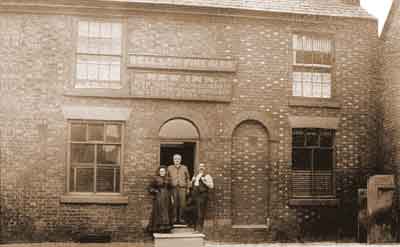 |
The New Inn, c.1901. The publican, John Austin, is standing in the doorway, with his daughter, Mary Homena Brown, on his right, and son-in-law, Arthur Brown, on his left. This beerhouse was located next door to the Primitive Methodist Chapel, off the picture to the left, and opposite the Bay Horse. The inn was first licensed in 1869 and by 1882 Oliver Thomas was the publican but in this year he was replaced by John Austin. He died in 1905 and his widow, Sarah Elizabeth Austin, took over in 1906. In 1912 Arthur Brown became the publican and the inn remained with the Austin/Brown families until it closed on the 7 Jan 1950. Credit: F Rhodes. |
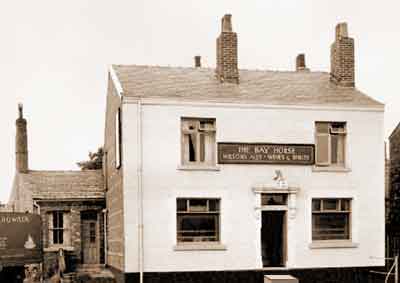 |
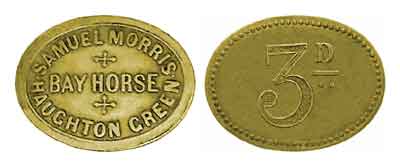 |
The Bay Horse, early 1950s. This public house dates from 1831 when it was owned by John Worth. In 1842 he let an upstairs room to the rector of St Lawrence’s Church, the Revd William Parr Greswell, for Sunday evening worship and lectures and this continued for several years afterwards. Following his death in 1850, aged 50 years, his widow, Mary Worth, took over and she stayed there until 1858 when George Barlow took over. It is understood that the name ‘Bay Horse’ originated when Victoria Colliery (aka Nibble and Clink Pit) near the public house used a favourite bay horse to haul coal. Bay is a hair-coat colour of horses, characterised by a reddish-brown or brown body colour with a black point colouration of the mane, tail, ear edges, and lower legs. |
3d brass token Issued by the Bay Horse during the tenancy of Samuel Morris, 1882-1901. |
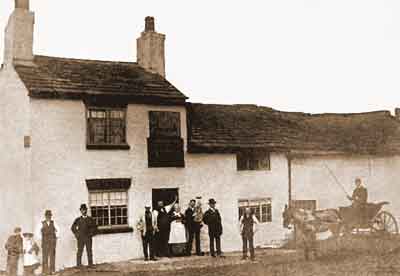 |
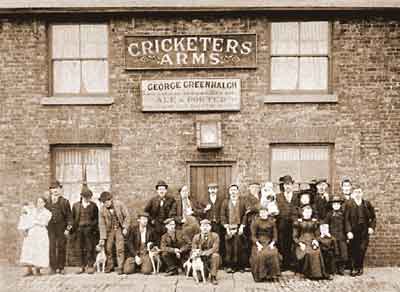 |
The Jolly Hatters, 1883. Situated on the south east side of Haughton Green Rd between Rivermead Rd and Church Ave, this beerhouse is understood to date from c.1850. This original building was replaced in c.1899. The landlord, John Brown, is standing in the doorway and his wife, Ann ‘Fanny’, Brown née Denerley is standing beside him. Next to her is their eldest son, Wright Brown, holding Fred Brown in his arms. The couple were married at St Stephen’s Church, Audenshaw, in 1860. John Brown was also the founder of John Brown (Denton) Ltd, manufacturer of hat wire and spokes for the cycle and motor trades. The works was nearby on Two Trees Ln. |
The Cricketers Arms, 1908. Situated on the north west side of Haughton Green Rd, opposite to the Jolly Hatters and the Lamb Inn, this beerhouse is understood to have been established in c.1780 by converting a cottage. In addition to beer drinking, patrons could also play skittles and quoits on the premises. The connection with the game of cricket is that locals dropped in for refreshments after playing a game on the village green. On the 22 October 1902 George Greenhalgh became the landlord and in this photo he is standing in the doorway. On the 19 December 1908 the Cricketers Arms was closed and it was converted back into a cottage. His tenure of the Cricketers Arms was 6 years 1 month and 28 days. The building was demolished in the 1920s. |
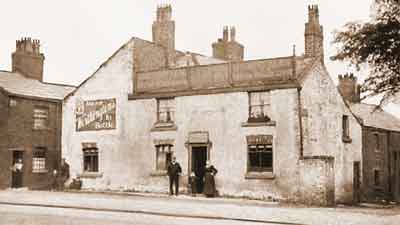 |
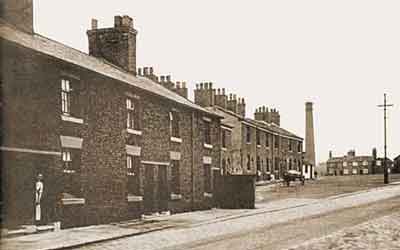 |
The Lamb Inn, c.1906. Situated on the south east side of Haughton Green Rd on the site of the entrance to Church Avenue, this beerhouse is understood to date from the 1760s. It closed on the 7 June 1907 but it was not demolished until 1926. The landlord, Samuel Hancock, his wife and a young boy are standing by the doorway. He became the landlord on the 3 May 1905, so his tenure of the Lamb Inn was just over 2 years. |
Haughton Green Rd, early 20th century. Viewed from Tommy Todd, Haughton Green, near the lychgate of St Mary's Church. King Pit Cottages, built in 1793, are on the left and between them and the next row of cottages was once the entrance to King Pit and King Pit Farm. The tall chimney belonged to Victoria Colliery (aka Nibble and Clink Pit) and it was demolished in 1923. |
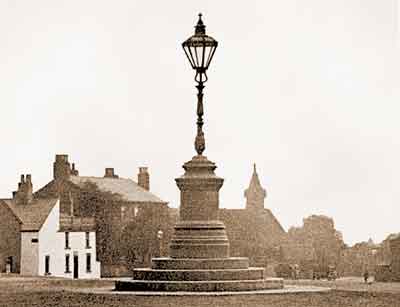 |
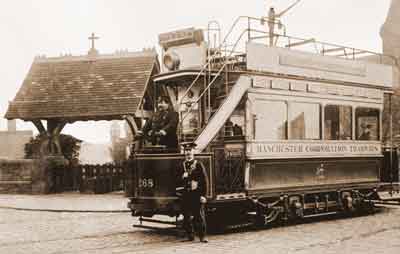 |
‘Tommy Dodd’ Gas Lamp. By 1884 a large stepped stone-based gas lamp, known as ‘Tommy Dodd’, stood in Denton market place. At this time Dentonians decided that they no longer wanted the lamp so it was offered to Haughton Green and this was accepted. Thus, towards the end of 1884, the dismantled lamp was taken to Haughton Green in a convoy of horse-drawn waggons to Betty’s Park, as the village green was then known. The convoy was escorted by a brass band and a public procession. The celebrations became known as the marriage of Tommy Dodd and Betty Haughton. The lamp stood on the village green for 20 years but during this time it got in the way of those who wanted to play games there and the glass in the lantern kept getting broken, so in 1905 it was decided that the lamp must be removed. The end was reported in the North Cheshire Herald on the 11 Mar 1905: Tommy Dodd’s services do not seem to be in much request. The Haughton Greenites do not want him, and the Dentonians have long discarded him, and he is now to be removed to the Town’s Yard, which will eventually be his last resting place. R.I.P. Once the lamp was in service at Haughton Green the village green became known as ‘Tommy Dodd’ but over the years it became known as ‘Tommy Todd’. |
Tramcar belonging to Manchester Corporation The tramcar is waiting by the lychgate of St Mary's Church. |
